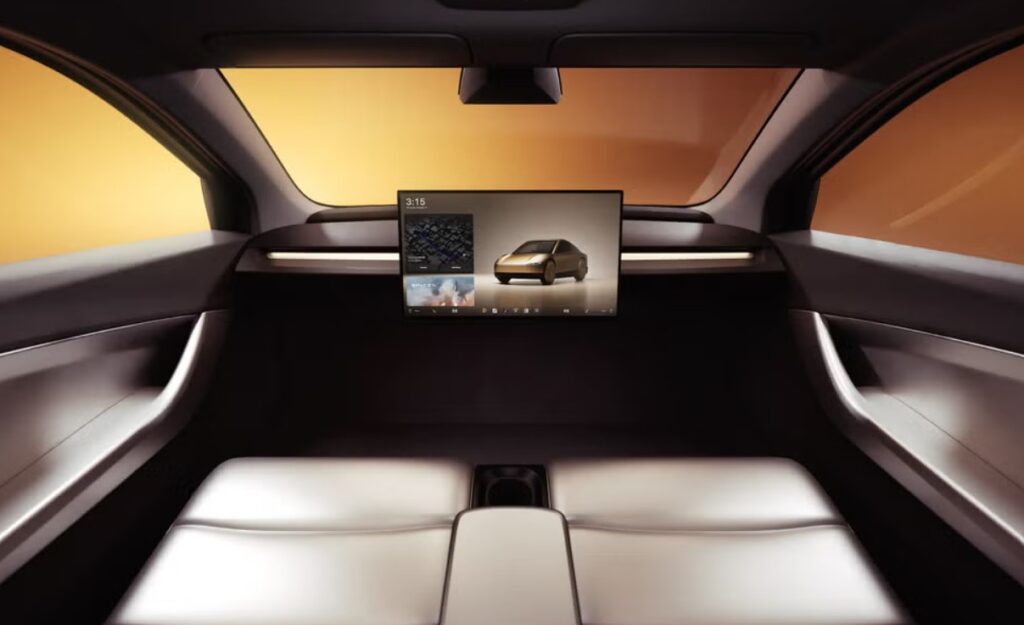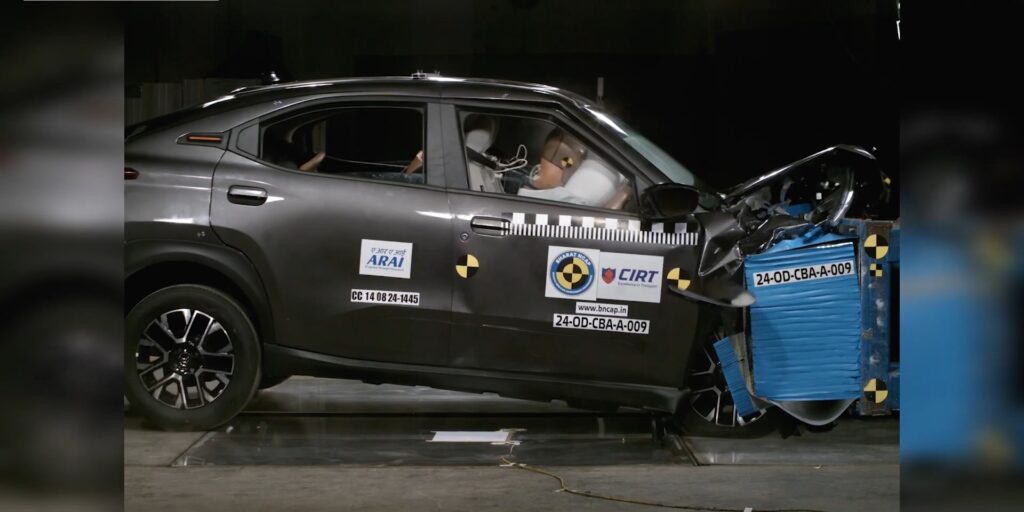Key Highlights
- Elon Musk has shared news about Tesla’s new robotaxi called the Cybercab. It aims to change how we get around.
- This fully autonomous vehicle will not have a steering wheel or pedals. It will depend completely on Tesla’s smart AI for navigation and safety.
- The Cybercab is expected to start running in Texas and California as soon as next year, but it needs regulatory approval first.
- It will use inductive charging, which makes it easy and efficient to power up.
- With production set to begin by 2026 or 2027, the Cybercab shows Tesla’s promise for an autonomous driving future.
Elon Musk has raised technology to new levels with the launch of Tesla’s Cybercab. This new project aims to make fully self-driving cars. The Cybercab is expected to reach India by 2027. It does not have a steering wheel or pedals. This means we are getting closer to a time when AI will drive the car. Tesla’s Cybercab might change how people travel in India.
Inside the Tesla Cybercab: Features and Innovations

The Cybercab was revealed at Tesla’s “We, Robot” event. It has a cool, futuristic design. The butterfly-wing doors open to reveal a simple cabin that fits two people. There are no usual controls, showing Tesla’s focus on autonomous driving. With inductive charging, you won’t need physical plugs anymore. This makes charging much easier.
Elon Musk, the CEO of Tesla, said the Cybercab will be a lot safer than cars driven by people. He thinks it could reduce accidents by 10 to 20 times. This priority on safety, combined with AI-driven efficiency, aims to change how we travel in cities.
Design and Safety Features Tailored for Indian Roads

The prototype displayed in California did not include a steering wheel. The version made for Indian roads should have a steering wheel for safety and to follow local rules. This change shows that Tesla wants to adapt its technology for different regions. Driving in India can be challenging due to heavy traffic and unexpected patterns.
Tesla wants to add many sensors and the newest AI programs to the Cybercab. This will help it drive easily in busy traffic on highways. Without a steering wheel, the inside can be changed. This could make riding better and safer for people. This special plan shows Tesla’s aim to innovate car design while making safety a top priority in autonomous driving.
The Integration of AI in Cybercab’s Navigation System
The Tesla Cybercab has a smart AI navigation system at its core. This system uses Tesla’s Unsupervised Full Self-Driving (FSD) technology. The Cybercab wants to improve autonomous driving. It relies on a network of cameras and sensors that provide data to the AI. This helps the AI make quick decisions while on the road.
Tesla imagines a future where Cybercabs learn from one another. They will share information to understand road conditions and driving habits better. This cooperation will help Cybercabs adjust to different areas. This matters a lot, especially in places with old or lacking maps.
The Cybercab’s AI will look at what is around it. It will learn from a lot of information. This will help it move through the difficult Indian roads in a better and safer way than humans do.
The Impact of Cybercab on India’s Transportation Landscape
The launch of Tesla’s Cybercab in India could really change the way we travel. Safe and efficient self-driving cars may help people in both cities and rural areas. The biggest impacts are likely to happen in big cities. These places often deal with heavy traffic and pollution.
Revolutionizing Urban Commute in India’s Mega Cities
Autonomous cars, like the Cybercab, can help lessen traffic problems in crowded cities in India. They may change how people travel every day. With these cars, commuters could feel more relaxed. They could use their travel time for other activities instead of worrying about driving.
The Cybercab uses electricity. This helps India create greener transport choices. If we change regular taxis and personal cars to electric self-driving vehicles, we can reduce carbon emissions. This will make the air cleaner in busy areas.
The Cybercab might change public transport. Many self-driving cars could provide ride-sharing services when people need a ride. This would offer a more flexible and better choice than regular buses and trains.
Economic and Environmental Benefits for Indian Society
The Cybercab is coming to India and it might change the economy a lot. Electric vehicles can help us use less fossil fuel. This means we can save money on fuel and have a more steady energy future for India. Also, shifting to electric vehicles opens up chances for new ideas and jobs in India’s car market.
The cost of the vehicle is still a big problem for many people. Tesla claims the price might go below $30,000. However, this still may be too high for the average Indian buyer. It’s very important to find ways to reduce this cost. This could be through government support or new payment plans. This will help make the Cybercab available to more people.
The Cybercab is a great choice for the environment. It has a small impact, making it a good option for eco-friendly transport. Some people worry about how batteries are made and thrown away. However, the significant decrease in emissions and less reliance on fossil fuels prove that the Cybercab can help reduce climate change in India.
Comparing Cybercab with Traditional Taxis and Ride-Sharing Services in India
The launch of Cybercab is going to change how people get around in India. It will likely affect regular taxis and ride-sharing services. Cybercab provides new comfort and fast service. Still, its success relies on a few factors. It needs to be affordable and must receive the proper government approvals. When we compare Cybercab to regular taxis and ride-sharing options, we can see several possible benefits.
Cost Efficiency and Availability
One big reason to pick Tesla’s Cybercab is that it might be cheaper to run. Since there is no human driver to pay, the cost of operating a Cybercab is probably much less than normal taxis or ride-sharing services. This could make rides more affordable for everyone and help Tesla make more money.
The cost to set up a group of Cybercabs is still high. Tesla may need to seek funding or find partners to help pay for these costs and hit its price target. Also, enough charging stations will be important for the Cybercabs to run well.
- Cost Efficiency: Lower costs happen because there are no human drivers. This helps provide better prices for rides.
- 24/7 Availability: Self-driving means Cybercabs can run all day and night. This could mean more service than traditional taxis, especially at night or during busy times.
- Safety Features: Smart AI and sensors work to lower human errors. This might make Cybercabs safer than regular taxis with drivers.
The Shift in Employment Patterns within the Taxi Industry
The growth of self-driving cars, such as the Cybercab, could lead to major changes in jobs within the taxi industry. As these cars become more popular, there may be a need for fewer human drivers. This shift could impact the earnings of many people. To address this change, we should focus on efforts like retraining programs and creating new job opportunities in the autonomous vehicle industry.
Tesla needs to deal with these challenges. This way, the change will be smooth and won’t harm society or the economy. It is important to get regulatory approval for the Cybercab to be used widely. Governments have to create clear rules and safety checks for self-driving cars to drive on public roads.
We don’t completely understand how this change in technology will impact everyone. However, discussing openly and collaborating with all sides will be important. This way, we can help ensure that the shift is fair for people who work in the taxi industry.
Conclusion
In conclusion, the Tesla Cybercab is a big step in changing how people get around in cities in India. It can save money and is good for the environment. It uses the latest AI technology to help with navigation. The design and safety features are made to handle Indian roads, which will change transportation for the better. When we compare the Cybercab to regular taxis, we see that this new service will save money and create new job chances in the industry. We are excited for its launch in 2027 because the Cybercab will give people better and greener ways to travel in India’s busy cities.
Frequently Asked Questions
How will Tesla ensure the safety of Cybercab passengers in India?
Tesla CEO Elon Musk said that safety is very important. The Cybercab will undergo tough tests on Indian roads. It will also need regulatory approval to ensure it is safe. Tesla is prepared to work with authorities. They want to address safety problems and build public trust.
Will Tesla’s Cybercab be affordable for the average Indian consumer?
The cost of the Cybercab for India is still unknown. However, Tesla wants to make it available for everyone. Musk has mentioned they hope to price it below $30,000. The company may consider subsidies or partnerships to keep it affordable for most people.
How does Tesla plan to overcome regulatory hurdles in India?
Tesla knows that following the rules is key to getting into the market. The company is willing to cooperate with Indian authorities. They will provide all necessary safety and technical details. They also want to ensure that their vehicles follow all government rules.
Can Cybercab operate in India’s diverse and challenging road conditions?
Tesla’s Cybercab is designed to be flexible. It uses new technology and AI to deal with many types of road conditions. The company thinks its technology can meet challenges and provide a smooth ride on Indian roads.
What are the expected environmental impacts of introducing Cybercabs in India?
The launch of electric vehicles, like the Cybercab, helps India achieve its goal of sustainable transport and reducing pollution. By using less fossil fuel, Cybercabs can help make the environment cleaner. They also contribute to better urban planning efforts.






